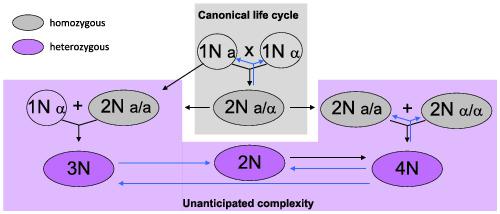Our official English website, www.x-mol.net, welcomes your feedback! (Note: you will need to create a separate account there.)
The budding yeast life cycle: More complex than anticipated?
Yeast ( IF 2.6 ) Pub Date : 2020-11-16 , DOI: 10.1002/yea.3533 Gilles Fischer 1 , Gianni Liti 2 , Bertrand Llorente 3
Yeast ( IF 2.6 ) Pub Date : 2020-11-16 , DOI: 10.1002/yea.3533 Gilles Fischer 1 , Gianni Liti 2 , Bertrand Llorente 3
Affiliation

|
The budding yeast, Saccharomyces cerevisiae, has served as a model for nearly a century to understand the principles of the eukaryotic life cycle. The canonical life cycle of S. cerevisiae comprises a regular alternation between haploid and diploid phases. Haploid gametes generated by sporulation are expected to quickly restore the diploid phase mainly through inbreeding via intratetrad mating or haploselfing, thereby promoting genome homozygotization. However, recent large population genomics data unveiled that heterozygosity and polyploidy are unexpectedly common. This raises the interesting paradox of a haplo‐diplobiontic species being well‐adapted to inbreeding and able to maintain high levels of heterozygosity and polyploidy, thereby suggesting an unanticipated complexity of the yeast life cycle. Here, we propose that unprogrammed mating type switching, heterothallism, reduced spore formation and viability, cell–cell fusion and dioecy could play key and uncharted contributions to generate and maintain heterozygosity through polyploidization.
中文翻译:

萌芽酵母生命周期:比预期更复杂?
近一个世纪以来,萌芽酵母酿酒酵母一直是了解真核生命周期原理的模型。S的规范生命周期。酿酒酵母包括单倍体和二倍体相之间的规律交替。通过孢子形成产生的单倍体配子有望主要通过四分体内交配或单倍体自交的近亲繁殖快速恢复二倍体阶段,从而促进基因组纯合化。然而,最近的大量人口基因组学数据表明,杂合性和多倍性出乎意料地普遍存在。这提出了一个有趣的悖论,即单倍双叶生物物种很好地适应近亲繁殖并能够保持高水平的杂合性和多倍性,从而表明酵母生命周期的复杂性出乎意料。在这里,我们提出未编程的交配类型转换、异种、孢子形成和生存能力降低,
更新日期:2020-11-16
中文翻译:

萌芽酵母生命周期:比预期更复杂?
近一个世纪以来,萌芽酵母酿酒酵母一直是了解真核生命周期原理的模型。S的规范生命周期。酿酒酵母包括单倍体和二倍体相之间的规律交替。通过孢子形成产生的单倍体配子有望主要通过四分体内交配或单倍体自交的近亲繁殖快速恢复二倍体阶段,从而促进基因组纯合化。然而,最近的大量人口基因组学数据表明,杂合性和多倍性出乎意料地普遍存在。这提出了一个有趣的悖论,即单倍双叶生物物种很好地适应近亲繁殖并能够保持高水平的杂合性和多倍性,从而表明酵母生命周期的复杂性出乎意料。在这里,我们提出未编程的交配类型转换、异种、孢子形成和生存能力降低,


























 京公网安备 11010802027423号
京公网安备 11010802027423号